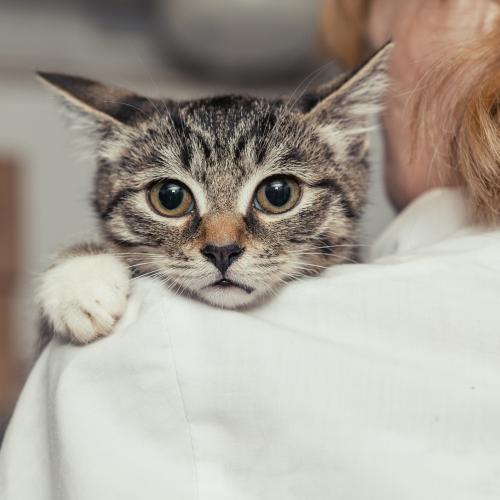
Are you dreading the next trip to the vet’s with your cat? We can help!
Back to overviewYou are here
Since animals age more quickly than humans, they should have a complete physical examination by a veterinarian every year. This is especially important in the case of cats because they are quite skilled at hiding any health problems that might crop up.
While visits to the vet are very important, some people might be tempted to avoid them because they can be stressful for both the animal and the owner. This is all the more true for cat owners, because, when stressed, felines can have a variety of upsetting physical and behavioral reactions such as yowling, spitting, scratching, and biting. In fact, their responses can even go so far as urinating, defecating, and vomiting. That is, of course, if you can find your cat when it’s time to go to the dreaded appointment!
The following tips can help make trips to the vet more enjoyable and less stressful for both you and your feline friend.
- Opt for a cat-friendly clinic. There aren’t very many of these clinics around and most are found in large metropolitan areas. They are, however, ideal for dialing down the stress caused by visits to the vet because they are staffed by specialized personnel. In addition, these clinics are specially designed to minimize stress that might be caused by things such as noise and odours. Another interesting option is a mobile veterinarian, that is, one who makes house calls, but they also tend to be located in large cities for the most part. Lastly, if neither of these two options are available, many small-animal clinics can make adjustments to handle the specific needs of frightened or stressed felines. Be sure to ask about such arrangements at the clinic.
- Do dry runs at home with your cat. Help him get used to his crate by leaving it open in a room in your home so that it can take on familiar odours. Place treats inside the crate to attract him inside. All of this will help create positive associations with the crate. You also need to handle your cat on a regular basis: touch his paws, claws, ears, and mouth. Make sure to pet and brush him...and reward him for being such a good sport. Lastly, get your cat used to riding in the car by going for short outings and not just for visits to the veterinarian.
- Learn to control your own stress on trips to the vet’s. Get things ready ahead of time to avoid being stressed by time: cats seem to know when we are stressed and in a hurry. Once in the exam room, talk to your cat in a soothing voice; pet her and gently play with her. And remember to reward her with her favorite treat during the exam and once you get back home.
There are other tips for desensitizing your cat and reducing stress during visits to the vet’s, as shown in these short videos:
- At the vet's (click here to watch video)
- In the car (click here to watch video)
Of course, all of these tips also apply to dogs.
Your pet can also be given calming supplements, such as Zylkene®, a few days before his annual checkup. Ask your veterinarian for more information about them.
Tips & Tricks
- Here are some tips to ensure your guests know how to interact with your dog during the Holiday season.
- Here are some tips to ensure a more pleasant stay for your friends and family with cat allergies.
- Do you know what pet insurance can cover? Here’s how it works.
- Contrary to dogs, cats have a profound hatred of costumes. Here’s why.
Products
- Zentonil®, to help support the cognitive function of aging pets, will help when your pet's liver is compromised…









